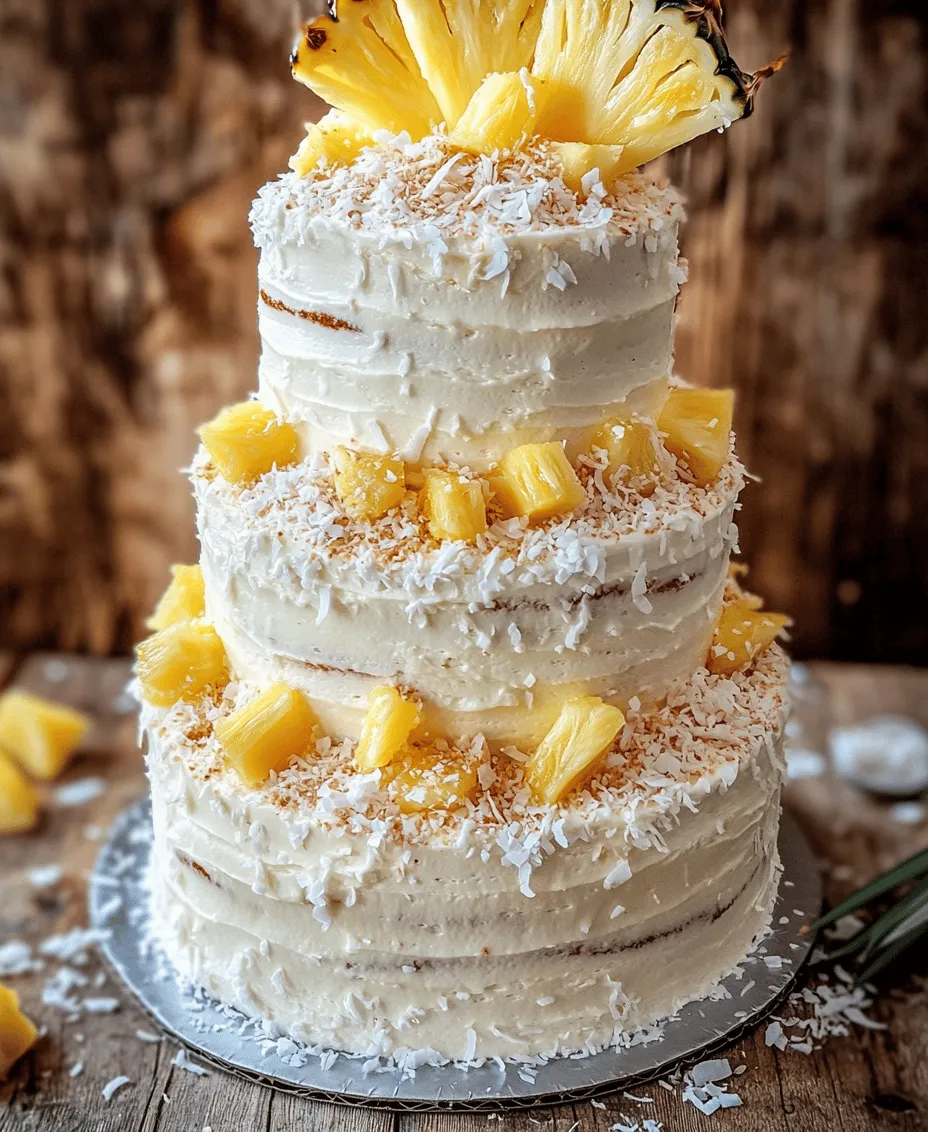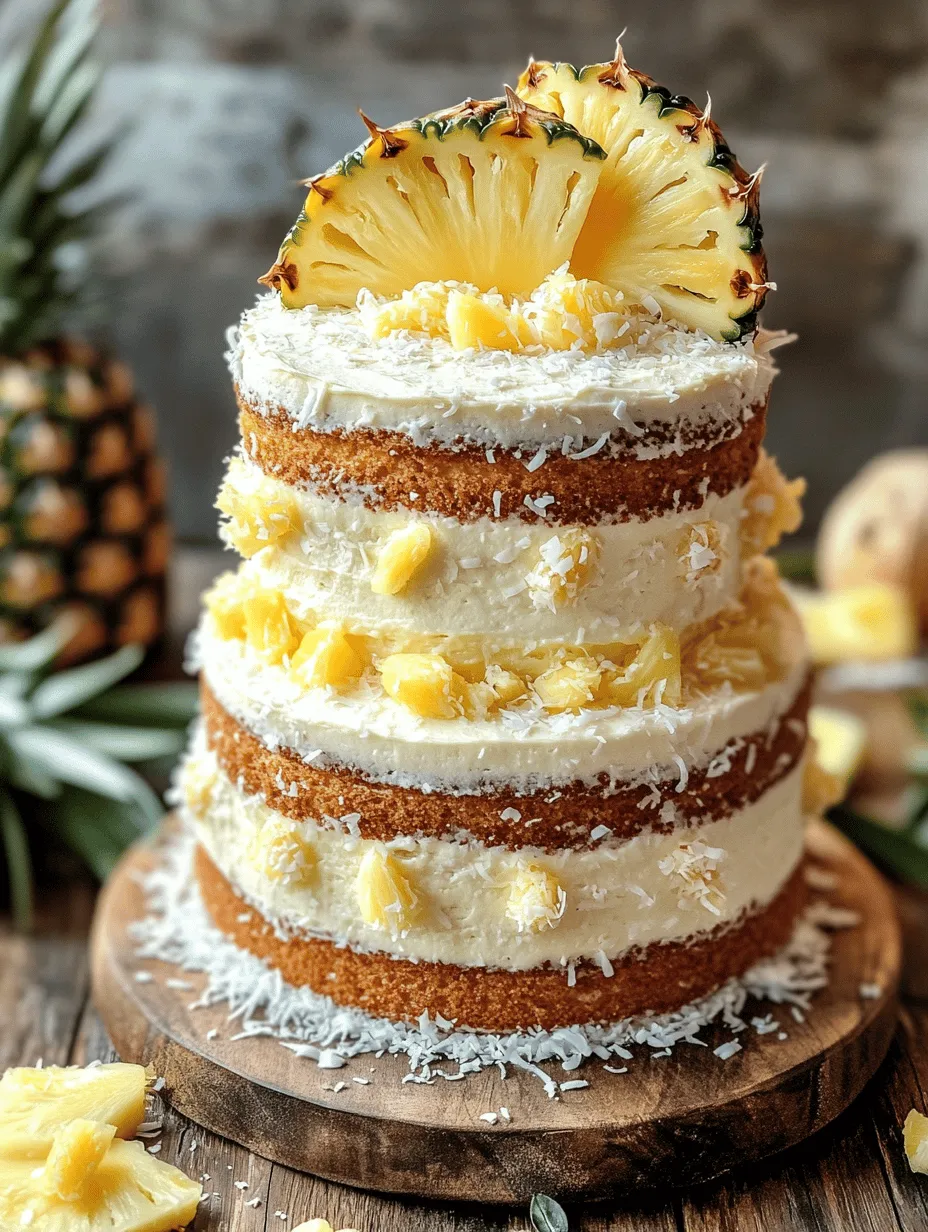The Pina Colada Layer Cake is not just a dessert; it is an experience that transports you to a sun-kissed beach, where the aroma of fresh coconut and juicy pineapple fills the air. This delightful cake is a perfect representation of the classic Pina Colada cocktail, combining the tropical flavors of coconut and pineapple into a beautifully layered confection. Ideal for summer celebrations, birthdays, or simply a treat to indulge in, this cake is sure to impress both family and friends alike.
A Brief History of Pina Colada
The Pina Colada has a rich history that traces back to Puerto Rico in the mid-20th century, although its roots can be found in earlier Caribbean rum cocktails that featured tropical fruits. The exact origin of the cocktail is somewhat disputed, with various claims to its invention, but it is undeniably a symbol of tropical paradise and vacation bliss. The name “Pina Colada” translates to “strained pineapple,” referring to the freshly pressed pineapple juice that is a key ingredient in the drink.
As the cocktail gained popularity, it inspired a variety of culinary creations, including desserts like the Pina Colada Layer Cake. This cake captures the essence of the cocktail, blending the sweetness of ripe pineapple, the creaminess of coconut, and a hint of rum flavor into a moist and luscious cake. The use of fresh and high-quality ingredients is crucial in achieving an authentic flavor profile that pays homage to its cocktail counterpart.
The Magic of Pina Colada Flavors
At the heart of the Pina Colada Layer Cake is its enchanting flavor profile, which features three main components: coconut, pineapple, and cream. Each element plays a vital role in creating a harmonious balance of sweetness and richness, reminiscent of sipping a Pina Colada on a beach under swaying palm trees.
Coconut
Coconut brings a distinct tropical flavor and texture to the cake. Whether it’s in the form of shredded coconut, coconut milk, or coconut extract, this ingredient is essential for achieving that signature Pina Colada taste. Its creamy richness elevates the overall flavor and adds a delightful chewiness to the cake layers.
Pineapple
The pineapple component adds a refreshing burst of sweetness and acidity, perfectly balancing the richness of the coconut. Using crushed pineapple not only imparts flavor but also contributes moisture to the cake, ensuring that each slice is tender and juicy. This vibrant fruit evokes feelings of summer and relaxation, making it a popular choice in desserts.
Cream
The creamy element of the cake comes from the use of cream cheese frosting, which complements the tropical flavors beautifully. This frosting adds a tangy sweetness that enhances the overall dessert experience, providing a contrast to the cake’s moist layers. The combination of these three flavors creates a delightful cake that transports you to a tropical paradise with every bite.
Cultural Significance
In many tropical regions, particularly in the Caribbean, the Pina Colada is not just a drink; it is a cultural icon that signifies leisure, celebration, and the joy of island life. Its popularity has led to its incorporation into various culinary delights, allowing people to enjoy the essence of the cocktail in different forms. The Pina Colada Layer Cake honors this tradition by bringing a taste of the tropics into homes far and wide, creating a sense of connection to the vibrant cultures that celebrate this refreshing beverage.
Ingredients Overview
Creating the perfect Pina Colada Layer Cake requires a thoughtful selection of ingredients. Each component contributes to the cake’s flavor, texture, and overall appeal. Here’s a detailed breakdown of the ingredients you will need:
All-Purpose Flour
All-purpose flour serves as the primary structure of the cake. It provides the necessary stability and texture, allowing the cake to rise and hold its shape while remaining tender. For best results, consider sifting the flour with other dry ingredients to ensure an even texture.
Granulated Sugar
Sugar not only sweetens the cake but also plays a crucial role in moisture retention. The granulated sugar creates a tender crumb, ensuring that the cake remains soft and enjoyable. It also contributes to the cake’s golden-brown color as it caramelizes during baking.
Unsweetened Shredded Coconut
Adding unsweetened shredded coconut enhances the coconut flavor and provides a delightful texture. Look for high-quality coconut that is free from additives to ensure the best flavor profile. This ingredient will add both chewiness and a visual appeal to the cake.
Baking Powder and Salt
Baking powder is essential for leavening the cake, allowing it to rise and become fluffy. Salt is equally important as it enhances the overall flavor and balances the sweetness of the cake. Together, they ensure a light and airy texture.
Unsalted Butter
Butter is a key ingredient that contributes to the richness and moisture of the cake. Unsalted butter allows for better control of the cake’s salt content, ensuring that the flavors are balanced. Be sure to bring the butter to room temperature before mixing for optimal incorporation.
Eggs
Eggs act as a binding agent, helping to hold the ingredients together while also providing structure. They contribute to the cake’s moisture and richness, making each slice decadent and satisfying.
Coconut Milk
Using coconut milk in the batter adds creaminess and enhances the coconut flavor. It contributes to a rich, moist cake that is reminiscent of the Pina Colada cocktail. Opt for full-fat coconut milk for the best results, as it will provide a luscious texture.
Crushed Pineapple
Crushed pineapple is a star ingredient that brings sweetness and moisture to the cake. It also imparts a vibrant tropical flavor, making every bite a burst of refreshing goodness. Be sure to drain the pineapple well to avoid excess moisture in the batter.
Vanilla and Coconut Extracts
These extracts amplify the flavor profile of the cake, enhancing the coconut and vanilla notes. A splash of vanilla extract adds warmth and depth, while coconut extract intensifies the tropical flavor.
Cream Cheese Frosting
The cream cheese frosting is the perfect complement to the Pina Colada Layer Cake. Its tangy sweetness balances the rich flavors of the cake and provides a creamy texture that is both satisfying and indulgent.
Decoration Options
To elevate the visual appeal of your cake, consider decorating it with additional shredded coconut and fresh pineapple slices. This not only enhances the tropical theme but also adds texture and flavor to each serving.
Preparation Steps for the Perfect Layer Cake
To create a Pina Colada Layer Cake that is as delicious as it is beautiful, follow these detailed preparation steps. Each step is crucial in ensuring that your cake turns out perfectly.
Mixing Dry Ingredients
Start by preheating your oven to 350°F (175°C) and greasing your cake pans. Next, combine the all-purpose flour, baking powder, and salt in a mixing bowl. It’s important to sift these ingredients together to ensure an even distribution of the leavening agents and to prevent clumps. Sifting also aerates the flour, resulting in a lighter texture for your cake.
Combining Wet Ingredients
In a separate large mixing bowl, cream together the unsalted butter and granulated sugar until light and fluffy. This process incorporates air into the mixture, which is vital for achieving a light and airy cake. Once the butter and sugar are well combined, add the eggs one at a time, mixing well after each addition. This step is crucial for ensuring that the eggs are fully incorporated, contributing to the structure of the cake.
Next, add the coconut milk, crushed pineapple, and extracts to the wet mixture. Mix until everything is well combined, being careful not to overmix. Overmixing can lead to a dense cake, so aim for a smooth batter with minimal lumps.
Incorporating Dry Ingredients into Wet
Gradually add the dry ingredient mixture to the wet ingredients, folding gently with a spatula until just combined. It’s essential to mix until no flour streaks remain but to avoid overmixing. This step will help maintain the cake’s light texture.
Baking the Cake
Evenly distribute the batter into the prepared cake pans and smooth the tops with a spatula. Bake in the preheated oven for approximately 25-30 minutes or until a toothpick inserted into the center comes out clean. Once baked, allow the cakes to cool in the pans for about 10 minutes before transferring them to a wire rack to cool completely.
As the cakes cool, you can prepare the cream cheese frosting and gather your decoration supplies for the finishing touches. This careful preparation ensures that each layer of the cake is moist, flavorful, and ready to be transformed into a stunning dessert that embodies the spirit of the tropics.
Stay tuned for the next section, where we will dive into the steps for frosting and decorating your Pina Colada Layer Cake, ensuring it is as beautiful as it is delicious!

Creaming Butter and Sugar: Techniques for Achieving a Fluffy Mixture
The foundation for a light and airy cake begins with the creaming of butter and sugar. Start with softened unsalted butter; this is crucial as it allows for easy incorporation of air. Use a stand mixer or hand mixer on medium speed to beat the butter until it becomes pale and fluffy, usually taking about 3-5 minutes. The light texture of the mixture results from tiny air pockets forming within the butter, which will expand during baking, creating a tender crumb.
To achieve the best results, ensure your butter is at room temperature—about 68-70°F. If you forgot to take it out of the fridge, you can cut it into small pieces or microwave it briefly at low power, checking frequently to prevent melting. Gradually add granulated sugar to the creamed butter while mixing, which helps to further aerate the mixture. You should aim for a fluffy consistency where the mixture resembles a light, pale paste.
Incorporating Eggs: How to Ensure Even Mixing
Once your butter and sugar are well-creamed, it’s time to incorporate the eggs. This step is vital for binding the ingredients together and adding moisture. Use large eggs at room temperature for optimal results. Crack the eggs into a separate bowl before adding them to the mixing bowl, which helps catch any shell fragments and allows for easier incorporation.
Add the eggs one at a time, mixing thoroughly after each addition. This ensures that the eggs emulsify with the butter-sugar mixture, preventing any separation that could lead to a dense cake. Scrape down the sides of the mixing bowl with a spatula after each egg to ensure everything is evenly combined. The mixture should appear smooth and glossy once all eggs are added.
Adding Liquids: Importance of Gradual Addition for a Smooth Batter
Incorporating liquids into your cake batter is a delicate process. For the Pina Colada Layer Cake, this typically includes coconut milk and any additional flavor extracts, like vanilla. Add these liquids gradually to the batter, alternating with the dry ingredients to maintain a balanced structure.
Start by adding a small amount of coconut milk, mixing on low speed until just combined. Follow with a portion of the dry mixture (flour, baking powder, and salt), and continue alternating until everything is incorporated. This method helps prevent the batter from becoming overmixed, which can lead to toughness.
Folding in Crushed Pineapple: Techniques to Maintain Airiness
The star ingredient of this cake is the crushed pineapple, which adds moisture and flavor. To fold in the pineapple without deflating the batter, use a rubber spatula. First, make sure to drain the excess juice from the crushed pineapple; too much liquid can affect the cake’s structure.
Gently add the crushed pineapple into the batter, using an under-and-over motion to incorporate it without overmixing. The goal is to maintain the lightness of the batter while ensuring the pineapple is evenly distributed throughout.
Baking Tips
Importance of Oven Temperature and Baking Time
Getting the oven temperature right is crucial to achieving the perfect Pina Colada Layer Cake. Preheat your oven to 350°F (175°C) and ensure it is fully heated before placing your cake pans inside. This allows the cakes to rise evenly.
Typically, baking time for 9-inch round cakes ranges from 25 to 30 minutes. Keep an eye on them towards the end of the baking time, as ovens can vary significantly.
How to Test for Doneness: The Toothpick Method Explained
To test for doneness, insert a toothpick or a cake tester into the center of the cake. If it comes out clean or with a few moist crumbs attached, the cakes are ready to come out of the oven. If the toothpick comes out with wet batter, give the cakes a few more minutes.
Cooling the Cakes: Why Proper Cooling is Essential for Frosting Application
Once you’ve pulled your cakes from the oven, allow them to cool in the pans for about 10-15 minutes. This cooling time helps the cakes to set, making them easier to remove without breaking. After this initial cooling period, carefully run a knife around the edges before inverting the cakes onto a wire rack.
The cakes must cool completely before frosting; otherwise, the heat can melt your cream cheese frosting, resulting in a gooey mess. It’s best to let them cool for at least an hour.
Layering and Frosting Techniques
Step-by-Step Instructions for Assembling the Cake
1. Level the Cakes: Once the cakes are completely cool, check for any doming on the tops. If necessary, use a serrated knife to level them off, ensuring a flat surface for stacking.
2. Stacking Layers Evenly: Place one layer of cake on a serving plate or cake stand. Spread a generous amount of cream cheese frosting on top, making sure to reach the edges. Place the second layer on top, ensuring it is centered. Repeat with any additional layers.
3. Crumb Coat: Apply a thin layer of frosting around the sides and top of the cake to seal in any crumbs. Chill the cake in the refrigerator for about 30 minutes to set the crumb coat.
4. Final Frosting Layer: Once the crumb coat is firm, apply a thicker layer of frosting all around the cake. Use a spatula to create a smooth finish.
Techniques for Spreading Cream Cheese Frosting Smoothly
To achieve a smooth finish with your cream cheese frosting, dip your spatula in hot water, then dry it off before spreading. The warmth helps the frosting glide smoothly over the cake.
For a textured look, you can use the back of a spoon or a spatula to create swirls or peaks.
Decorating the Cake
Creative Ideas for Using Shredded Coconut and Pineapple Slices
For an eye-catching presentation, top your frosted cake with a generous amount of shredded coconut. You can toast the coconut slightly in a dry skillet over medium heat for added flavor and a golden color.
For an added tropical flair, use fresh pineapple slices or wedges as decoration. Arrange them artistically on top or around the sides of the cake. Edible flowers can also enhance the tropical aesthetic.
Tips for Achieving a Beautiful Presentation
To make your Pina Colada Layer Cake visually stunning, consider using a cake scraper to smooth out the frosting. Additionally, placing a few cocktail umbrellas or decorative picks can add a fun, festive touch.
Serving Suggestions and Pairings
The Pina Colada Layer Cake is perfect for various occasions. Its tropical flavors make it an ideal centerpiece for birthday celebrations, summer barbecues, and tropical-themed parties.
Beverage Pairings That Complement the Tropical Flavors
To complement the cake’s rich flavors, consider serving it with a refreshing drink. Cocktails like a classic Pina Colada or a Mojito work beautifully, bringing the tropical theme together. For a non-alcoholic option, a coconut-infused lemonade or a tropical fruit punch can be equally delightful.
Storage Recommendations to Maintain Freshness
To keep your Pina Colada Layer Cake fresh, store it in an airtight container at room temperature for 2-3 days. If you need to keep it longer, refrigerate it, which can extend its shelf life up to a week. Before serving, allow it to come back to room temperature for the best taste and texture.
Nutritional Information
A standard serving of Pina Colada Layer Cake (1 slice) contains approximately:
– Calories: 350
– Total Fat: 20g
– Saturated Fat: 12g
– Cholesterol: 70mg
– Sodium: 250mg
– Total Carbohydrates: 40g
– Dietary Fiber: 1g
– Sugars: 25g
– Protein: 4g
Discussion on Dietary Considerations
For those with dietary restrictions, consider using gluten-free flour to make this cake suitable for a gluten-sensitive audience. You can also substitute the granulated sugar with coconut sugar or a sugar alternative to cater to those watching their sugar intake. For a dairy-free version, use plant-based cream cheese and coconut oil in place of butter.
Conclusion
Creating and enjoying a Pina Colada Layer Cake is not just about satisfying your sweet tooth; it’s about bringing a taste of the tropics into your kitchen. The combination of moist cake, rich cream cheese frosting, and the delightful crunch of coconut and pineapple makes this dessert a celebration in itself.
Feel free to experiment with variations, such as adding rum flavoring to intensify the tropical essence or incorporating fresh fruit between the layers for added texture. This cake is a beautiful symbol of celebration, evoking feelings of joy and festivity. So, gather your ingredients, unleash your inner baker, and indulge in the allure of this delicious Pina Colada Layer Cake.

